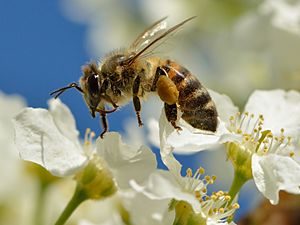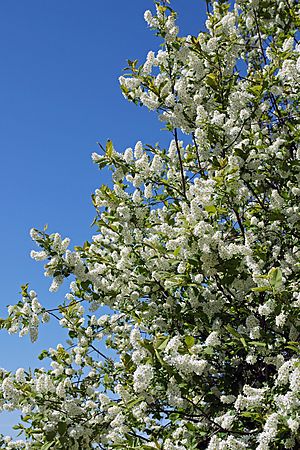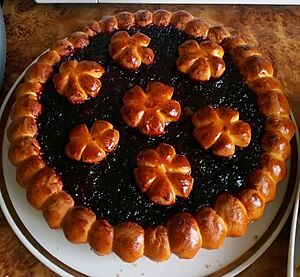Prunus padus facts for kids
Quick facts for kids Prunus padus |
|
|---|---|
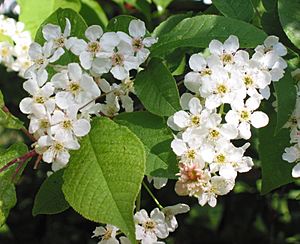 |
|
| Bird cherry flowers | |
| Conservation status | |
| Scientific classification | |
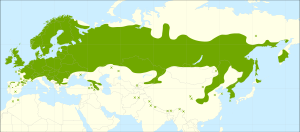 |
|
| Distribution map | |
| Synonyms | |
|
List
|
The Bird Cherry (scientific name: Prunus padus) is a type of flowering plant in the rose family. It is also known by other names like hackberry or Mayday tree. This plant is a kind of cherry that loses its leaves every year (it's deciduous). It can grow as a small tree or a large shrub, reaching up to 16 meters (about 52 feet) tall.
Bird cherries are special because their flowers grow in long clusters called racemes. You can find them naturally in northern Europe and across northern and northeast Asia. People also plant them in North America because they are beautiful ornamental plants.
Contents
Where Bird Cherries Grow
Bird cherries are originally from eastern, central, and northern Europe. They also grow across the middle parts of Asia, including Japan.
European and Asian Homes
In Europe, you can find them north of the Pyrenees mountains and the Alps. They also grow south of the treeline. Small groups of them are even found in Spain and Portugal, Northern Italy, and parts of North Africa. They are common in all of Eastern Europe, north of the Balkan Mountains and the Steppe grasslands. You can also see them in the Caucasus region.
In Asia, bird cherries live in the forests of Siberia, the Russian Far East, Korea, Hokkaido, and parts of China. Some are even found in the Himalayas.
Bird Cherries in North America
The Mayday tree, which is another name for the bird cherry, is very common in Anchorage, Alaska. Many people there have planted them in their gardens and yards.
What Bird Cherries Look Like
The fruit of the bird cherry is called a drupe, which is a type of stone fruit. It tastes very bitter or "astringent" because it contains something called tannin.
There are two main types, or varieties, of bird cherry:
- European bird cherry (Prunus padus var. padus): This type grows in Europe and western Asia.
- Asian bird cherry (Prunus padus var. commutata): This type is found in eastern Asia.
Bird Cherry Ecology
Flowers and Pollination
The flowers of the bird cherry have both male and female parts (they are hermaphroditic). Bees and flies help to pollinate them.
Fruit and Birds
Birds love to eat the fruit of the bird cherry. They don't mind the bitter taste at all!
Pests and Diseases
In Europe and Asia, a moth called the Bird-cherry ermine moth (Yponomeuta evonymella) uses the bird cherry as its main food source. The caterpillars of this moth can sometimes eat all the leaves off a single tree.
In North America, the tree can get a disease called black knot fungus.
Is Bird Cherry Poisonous?
Some parts of the bird cherry, like the leaves, stems, and fruits, contain natural chemicals called glycosides. These include prulaurasin and amygdalin. These chemicals can be harmful or even poisonous to some animals, especially certain mammals.
Uses of Bird Cherries
The fruit of the bird cherry is not used very often in western Europe today. However, long ago, it might have been an important food source in eastern regions.
Historical Food Use
About 2,500 years ago, a Greek historian named Herodotus wrote about a group of people called the Argippaeans. They lived near the Ural Mountains and were said to be bald from birth. Herodotus wrote that these people would pick small, bean-sized fruits from a tree they called "pontic." They would squeeze a dark juice from these fruits and make a type of cake from what was left over. This juice and the cakes were their main food.
It is believed that the "pontic" tree might have been the bird cherry. Even later, the Cossacks in Russia were said to make a similar juice from Prunus padus.
Modern Culinary Uses in Russia
In Russia, people still use the fruit of the bird cherry for cooking. The dried berries are ground into a flour. This flour is the main ingredient for a special dessert called bird-cherry cake. The flour and the cake are brown, even though there is no chocolate in them. You can buy both the flour and the cake in local stores and bakeries. Fresh bird cherries can also be chopped up and cooked to make jam.
Ornamental Tree
The Asian variety of bird cherry, Prunus padus var. commutata, is sold as an ornamental tree in North America. It is known as the Mayday tree. People like it because it is very strong and can handle cold weather. They also love its beautiful, sweet-smelling white flowers that bloom in spring. The name "Mayday tree" comes from the May Day festival, which celebrates spring. It has nothing to do with the "mayday" distress signal.
Other Uses and Beliefs
In some parts of Scotland, like Advie, people believed that the wood of the hackberry (bird cherry) was a "witches tree." They thought it was bad luck to use its wood.
During the Middle Ages, people used parts of the bird cherry for medicine. Some also believed that placing the bark of the tree at their door could help protect them from the plague.
Bird Cherry in Culture
In Finland and Sweden, when the bird cherry (called tuomi in Finnish) starts to bloom, it is a sign that summer has begun for many people. In southern Finland, this usually happens in the last two weeks of May or at the very beginning of June.
See also
 In Spanish: Cerezo de racimos para niños
In Spanish: Cerezo de racimos para niños



